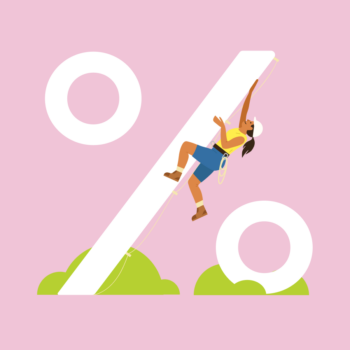Looking to enter the property market and caught word interest rates might be dropping?
Fiiiiiinally!
But before you spend your waking hours on realestate.com or break out the fancy cheese … what do interest rate cuts actually mean for home buyers? Are interest rate cuts a good or a bad thing? And is now the time to buy a house?
Let’s take a closer look.
First, what causes interest rates to drop?
Interest rates don’t rise and fall for the fun of it.
In fact, there are a few factors that determine interest rates on home loans, and it’s largely a reflection of what’s going on in the economy at that particular time.
The two key parties involved in determining interest rates on home loans are the Reserve Bank of Australia (RBA) and lenders (AKA the banks).
Firstly, the Reserve Bank of Australia (RBA) is Australia’s central bank and the primary decision-maker when it comes to Australia’s monetary policy. The RBA plays a big role in the stability of our currency, employment rates and economic prosperity. The RBA sets a thing called the ‘cash rate’ which is the benchmark interest rate used for loans between the banks.
Now, the lenders’ role in all this. A change in the RBA cash rate will change how much it costs lenders to borrow money, so typically, lender interest rates will closely follow the RBA’s cash rate, having flow-on effects to your home loan.
So long story short: what the RBA does matters and has a trickle-down effect on home buyers.
But how does the RBA decide the cash rate?
Once again, it’s not for the fun of it.
The RBA sets the cash rate to achieve two main objectives: to keep consumer price inflation between 2 and 3 per cent and achieve sustained full employment (remember what we said earlier about the RBA playing a big role in our economy?)
If we look at where we are in February 2025, inflation has been above 3 per cent since mid-2021. So the RBA has been increasing the cash rate (and therefore maintaining high rates) since then in an effort to slow down inflation.
But the good news – their strategy worked. Inflation is now back below 3 per cent so the RBA is expected to reduce rates over the coming months. And when they do that, lenders will typically follow.
So, what do dropping interest rates mean for first home buyers?
A few things (and mostly good things!)
There are generally one of two possible outcomes home buyers can achieve when rates come down: lower repayments or higher borrowing power.
- Potential increase in borrowing power
Your ‘borrowing power’ or ‘borrowing capacity’ is how much a bank is willing to lend you so you can buy a property. A lender assesses your borrowing power to feel confident you’re only borrowing as much as you can pay back.
When interest rates are lower, your borrowing power can increase because the cost of borrowing money decreases. With lower interest, a smaller portion of your repayments goes toward interest, leaving more room to pay down the principal balance — so lenders may approve you for a larger loan.
It’s important to note, lenders will still add a ‘serviceability buffer’ to provide comfort that a borrower could continue to afford the loan if interest rates increase.
- Potential for lower repayments
This one’s pretty straightforward. If you’re paying less interest, your monthly repayments may initially be lower than what they would have otherwise been. But remember, rates and repayments will still fluctuate over the life of your loan.
But what about increased demand?
The not-so-good news. While lower interest rates can lower the cost of borrowing money to buy a property, others might have the same idea. So it can also drive up demand in the housing market, which might push house prices up.
Of course, this is generally speaking. House prices also depend on the area, property type and a bunch of other factors.
So, are interest rate cuts good or bad?
In a nutshell, interest rate cuts can make buying your first home easier by reducing the cost of borrowing money, but it can also drive up demand in the housing market.
Remember, it’s often a good idea to take a holistic view of the market and your situation and keep in mind the market can shift over the life of your loan.
Will interest rates rise again … eventually?
Just like interest rates can go down, they can go up, too. That’s the nature of the economy. Over the life of a 30 year home, it’s almost certain you’ll experience both rate cuts and rate rises. For example, between 1995 – Feb 2025 (the life of a typical loan) there’s been 37 rate increases and 36 rate decreases (source).
When approving your home loan, lenders will add a ‘serviceability buffer’ to add a layer of reassurance that you’ll still be able to afford the loan if interest rates increase.
Learn more about what rising interest rates mean for first home buyers.
What do dropping interest rates look like in practice?
Let’s take Karly, for example.
She has a pre-approval for a $650,000 loan at a rate of 6.22% p.a. At this rate, she can expect monthly repayments of $3,989.
However, thanks to her broker, she also ran the numbers on what an interest rate drop to 5.97% p.a. would look like.
In this case, she could potentially either decrease her repayments to $3,885 per month (a decrease of $105 per month) OR keep the same repayments and increase her borrowing power. This could look like pre-approval for a $667,400 loan ($17,400 more than her original pre-approval).
(Assumes a 30 year loan and principal and interest repayments).
Questions on interest rate cuts?
Will dropping interest rates affect property prices?
They can, yes. That’s because there might be a few home buyers in the same boat wanting to make the most of rate cuts, potentially driving up housing demand and prices. House prices also depend on the area, property type and a bunch of other factors.
Generally, do all lenders drop rates by the same amount?
It’s not easy to predict. Historically, lenders have behaved differently (generally not always the same as the RBA). But typically, a drop in RBA rates can lead to new interest rates coming down. Book a chat with a mortgage broker (or Finspo home loan expert) to find out what the current climate might mean for you.
If I buy a property, should I fix my mortgage rate when rates are low?
It depends on your situation. Fixing your rate locks in repayments, offering stability, while a variable rate may allow you to benefit from future cuts. Learn more here: should I fix my home loan?
Should I buy a house after interest rate cuts?
We wish we could give you a definitive yes or no answer, but unfortunately, it always comes down to your unique situation.
In many cases, a rate cut environment can allow home buyers to make the most of lower repayments or higher borrowing power. But it can also drive up demand in the housing market.
Find out exactly what dropping interest rates mean for your situation
As a first home buyer, dropping interest rates can potentially be something to celebrate! But it’s best to chat with a mortgage broker (that’s us!) to find out exactly what dropping interest rates mean for YOU.
In some cases, it may lower your repayments or increase your borrowing power.
Ready to explore your options? Chat with a friendly Finspo expert today for free.




